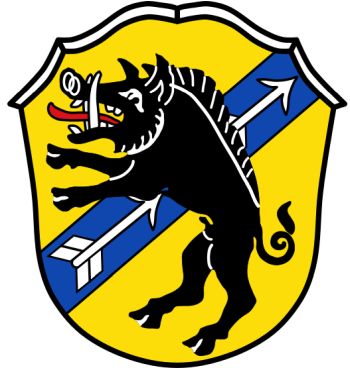Eberfingen: Difference between revisions
Jump to navigation
Jump to search
Knorrepoes (talk | contribs) m (Text replace - "|width="15%"|50 px|right |}" to "|width="15%"|50 px|right |}<seo title="Wappen, Gemeindewappen" />") |
Knorrepoes (talk | contribs) m (Text replace - "[[Literature" to "{{media}} [[Literature") |
||
| Line 21: | Line 21: | ||
The arms are based on the 19<sup>th</sup> century seal of the municipality, which showed three pine trees. The trees are, according to legend, the three trees that had to be cut down, when an Austrian soldier built the local chapel in 1733/34. The officer, when he was in mortal danger, had promised to built the chapel when he was rescued. | The arms are based on the 19<sup>th</sup> century seal of the municipality, which showed three pine trees. The trees are, according to legend, the three trees that had to be cut down, when an Austrian soldier built the local chapel in 1733/34. The officer, when he was in mortal danger, had promised to built the chapel when he was rescued. | ||
{{media}} | |||
[[Literature]] : Huber, 1982; legend from Wolfgang Löhle, Eberfingen. | [[Literature]] : Huber, 1982; legend from Wolfgang Löhle, Eberfingen. | ||
Revision as of 21:00, 8 July 2014
| Heraldry of the World Civic heraldry of Germany - Deutsche Wappen (Gemeindewappen/Kreiswappen) |
EBERFINGEN
State : Baden-Württemberg
District (Kreis) : Waldshut
Incorporated into : 1974 Stühlingen
Official blazon
In Silber auf grünem Boden drei grüne Tannen mit schwarzem Stamm.
Origin/meaning
The arms were designed and granted in 1906.
The arms are based on the 19th century seal of the municipality, which showed three pine trees. The trees are, according to legend, the three trees that had to be cut down, when an Austrian soldier built the local chapel in 1733/34. The officer, when he was in mortal danger, had promised to built the chapel when he was rescued.
Contact and Support
Partners:
Your logo here ?
Contact us
© since 1995, Heraldry of the World, Ralf Hartemink 
Index of the site
Literature : Huber, 1982; legend from Wolfgang Löhle, Eberfingen.











